Here’s why it works:
This system works for everything – fitness, finances, career, or personal growth. Start small, stay consistent, and see results in just 90 days.
Want to turn your big dreams into real results? A 90-day plan can help you do just that. Here’s how to create one that works.
Before jumping into your 90-day sprint, get clear on where you’re heading. Think about what you want to achieve in the next year or five years. This big-picture view will help you pick the right short-term targets.
Ask yourself: "Where do I want my career to be when this year ends?" If you’re juggling multiple goals, pick the ones that’ll make the biggest difference right now.
Break down your vision into focus areas. Let’s say you want better finances – you might zero in on budgeting, saving more money, and smart investing. This way, your 90-day plan stays connected to your bigger goals.
Now it’s time to set goals that stick. We’re talking SMART goals – Specific, Measurable, Achievable, Relevant, and Time-bound. This method turns fuzzy wishes into clear targets you can actually hit.
Here’s what good SMART goals look like:
Big goals can feel scary. That’s why you need to chop them into bite-sized pieces. Think of it like eating an elephant – one bite at a time.
Start with monthly targets. Writing a 30,000-word eBook? That’s 10,000 words per month. Then break it down further – 2,500 words each week. Finally, set daily tasks like writing 500 words.
As Dallas Romanowski puts it: "90-day plans simplify annual goals into digestible quarterly segments, making it easier to identify critical success factors and strategies" .
Simon Smith adds: "90-day goals are easier to track and measure, allowing for flexibility and adjustments as needed".
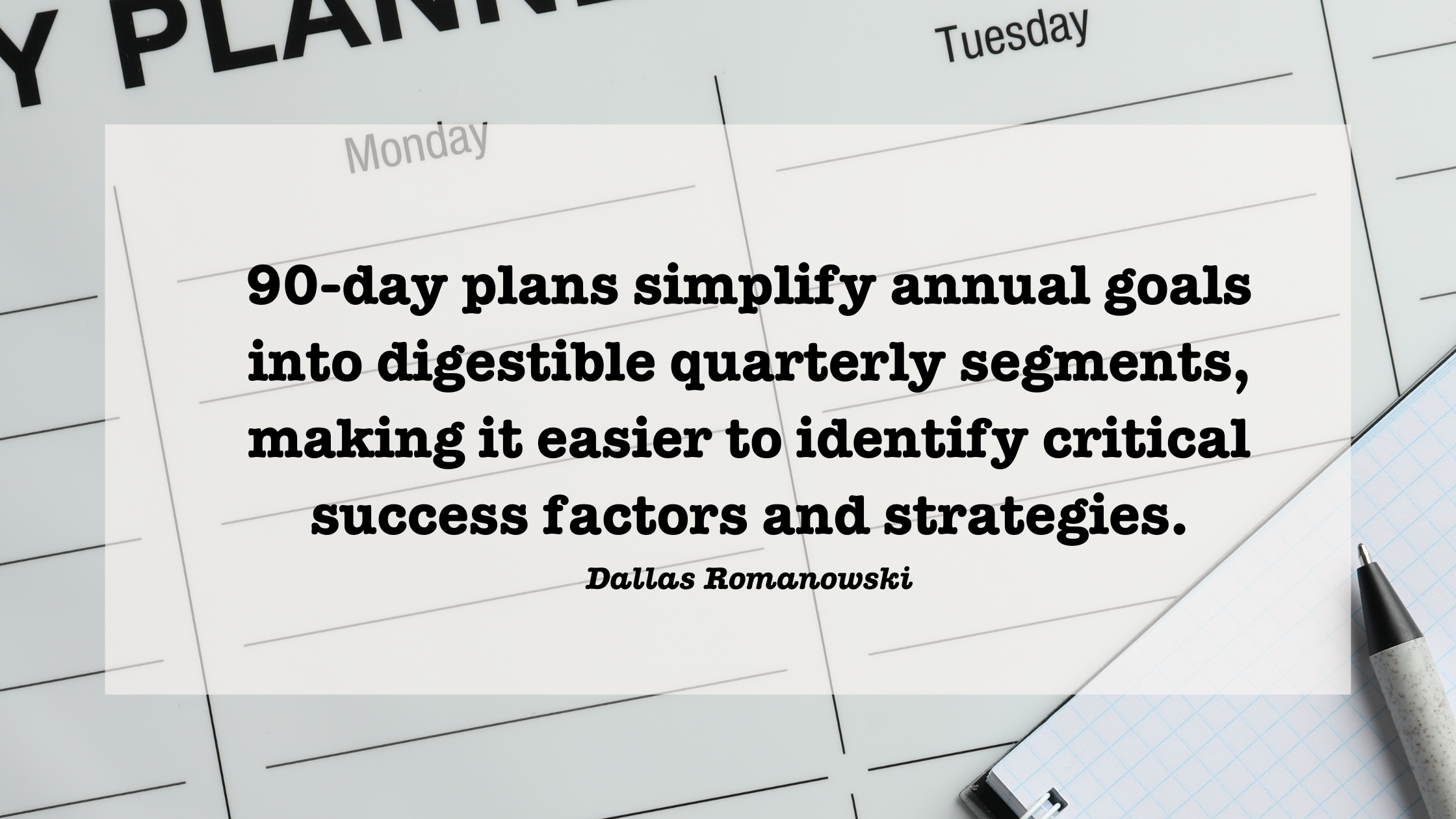 .
.
Life throws curveballs – we all know that. Check your progress often and don’t be afraid to adjust your plan. The key is moving forward, not sticking to a perfect schedule.
Got your 90-day goals mapped out? Let’s talk about how to actually make them happen. Here’s how to turn those plans into real results.
Start each week by picking the tasks that’ll move you closer to your goals. Whether you prefer the Hobonichi Weeks planner or a bullet journal, use what works for you. Add some visual flair with checklists or habit trackers to make your planning more fun and organized.
Let’s get specific: If you’re aiming to save $3,000, that means setting aside $250 each week. For fitness goals, block out exact times for workouts and meal prep.

Once you’ve mapped out your week, break it down into daily chunks. This keeps you focused and makes big goals feel less overwhelming.
Ever feel like you’re busy all day but get nothing done? That’s where time blocking comes in. It’s simple: assign specific time slots to specific tasks. No more jumping between emails, calls, and projects like a ping-pong ball.
Here’s why it works: When you focus on one thing at a time, you’ll get more done and feel less stressed. Plus, it’s flexible – if something takes longer than expected, just shift your blocks around.
At week’s end, take a good look at what’s working and what isn’t. Let’s say you planned to hit three industry events and add 15 LinkedIn connections, but by week six you’ve only made it to one event. Time to switch things up!
"You can’t manage what you don’t measure", states Michael Hyatt, founder of Full Focus.
These check-ins aren’t just about keeping score – they’re your chance to celebrate wins and spot where you might need to pivot. Whether you’re tracking progress in an app or with old-school pen and paper, seeing your progress helps keep you pumped and pointed in the right direction.
Let’s look at some practical tools that can make your 90-day planning easier and more fun. You’ve got two main options: good old-fashioned paper planners or digital apps. Here’s what works best.
Want to make planning more fun? Physical planners and stickers might be your thing. Whether you prefer the luxurious feel of Tomoe River paper with Hobonichi brand planners, or the structured vertical columns of the Erin Condren Life Planner, you need something to specifically track your short-term goals. It’s helpful to have daily and weekly schedules, ways to track your progress, and sections to check how you’re doing.
Here’s something cool: add some personality to your planner with stickers from Dark Moon Paper. Their sticker kit collections for Hobonichi Weeks, Hobonichi Cousin, and Vertical Planners aren’t just pretty – they’re super practical too. You’ll find checklists, habit trackers, and icons to mark different types of tasks.
Not into paper? No problem. Here are some apps that’ll help you nail your 90-day plans:
These tools give you the structure you need while being flexible enough to match your style. Pick what works for you and get ready to crush those 90-day goals.
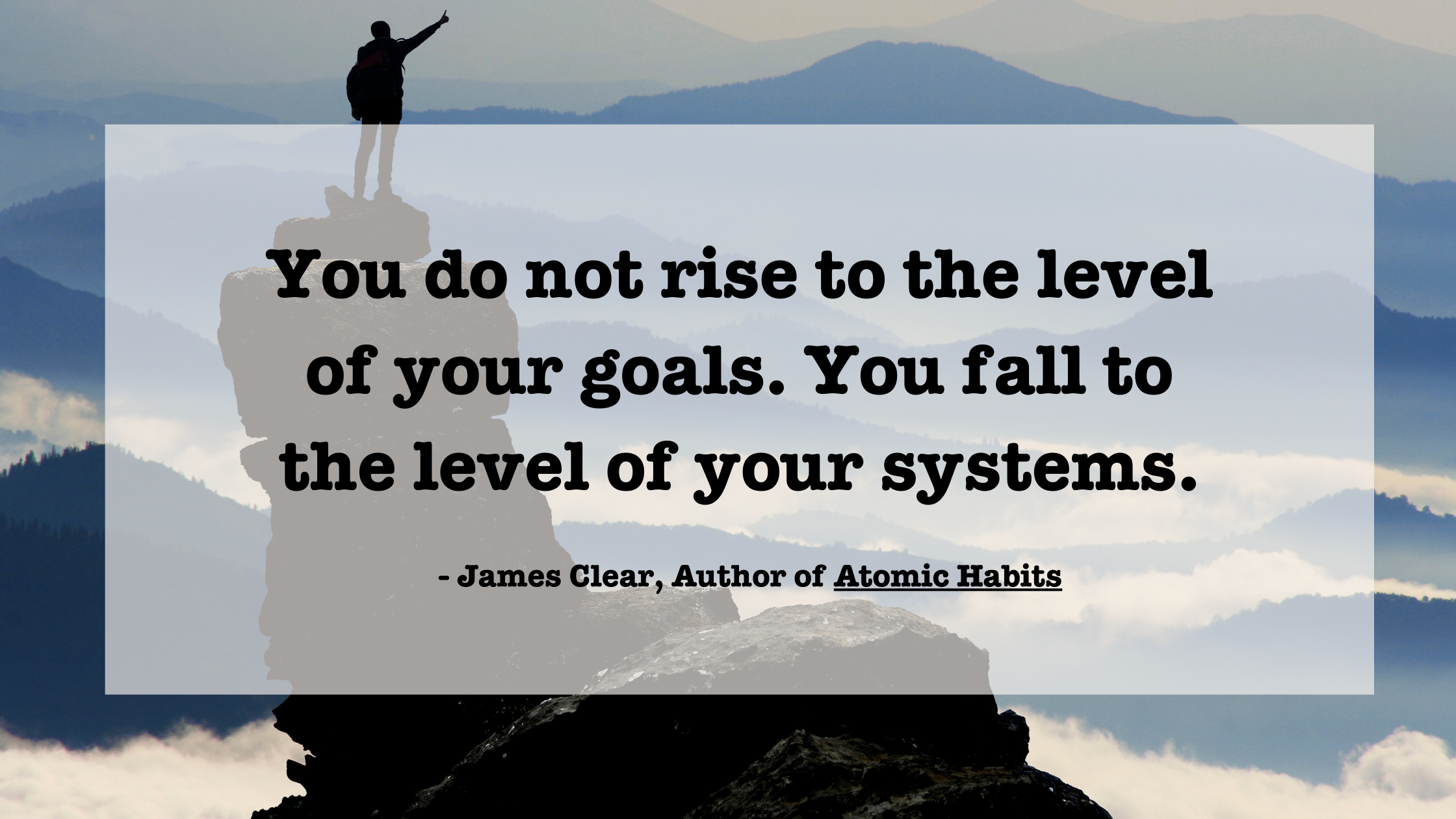
The 90-day framework helps turn big dreams into doable chunks. It’s like breaking down a cross-country road trip into smaller, daily drives – much less scary and way more manageable.
"One 90-day goal makes it easy to focus attention daily without having to adopt a new system or tool or app."
Think of it this way: instead of getting overwhelmed by a massive year-long goal, you’re tackling it quarter by quarter. You’ll use simple tools like time-blocking to stay on track, and weekly check-ins to make sure you’re headed in the right direction.
Here’s how to kick off your first 90-day sprint:
Start with your big picture – maybe it’s running that 10K you’ve been dreaming about. Then break it down into bite-sized pieces that don’t make you want to hide under your covers.
For example, instead of the vague "I want to get fit", try "I’ll do 30 workouts in 90 days." That’s just 10 workouts per month – totally doable, right?
Make it work for you:
The beauty of 90-day planning is its simplicity. You don’t need fancy apps or complicated systems – just a clear target and consistent action. Think of it as your personal GPS: it keeps you moving in the right direction while letting you take detours when life throws curveballs.
Pro tip: Add some personality to your planning. Maybe that means using your favorite colored pens or adding stickers to your calendar. Whatever makes the process fun for you is fair game.
Remember to celebrate those small victories – they’re the stepping stones to your bigger goals. Each workout completed, each milestone hit, brings you closer to where you want to be.
Your 90-day adventure starts now. Pick that goal you’ve been putting off and give it the 90-day treatment. You might be surprised at what you can accomplish in just one quarter.
Let’s tackle some common questions about putting your 90-day plan into action.
90 days hits the sweet spot – it’s long enough to make real progress but short enough to keep you motivated. Here’s how to make it work:
Pick specific, measurable targets. Skip vague goals like "get fit" and go for "hit the gym 3 times per week for 12 weeks straight."
Focus on what matters most. If you’re starting a side business, zero in on two key tasks: mapping out your business strategy and getting your website up and running.
Map it out week by week. Break down your big goal into smaller weekly targets. Then turn those into daily to-dos using your planning tool of choice.
Stay flexible but focused. Things won’t always go as planned – that’s okay. Check your progress weekly and tweak your approach when needed, but keep your eyes on the prize.
A goal journal keeps you on track and helps you spot what’s working (and what’s not). Here’s how to do it right:
Write like it’s happening now. Instead of "I want to save $3,000", try "I’m putting aside $1,000 monthly to hit my $3,000 target by April."
Make it visual. Draw simple progress bars or check boxes to track your daily wins. These visual cues make tracking fun and show how far you’ve come at a glance.
Set a weekly check-in. Take 15 minutes each week to answer two questions:
This keeps you honest about your progress and helps you spot patterns in what’s helping (or holding you back) from hitting your targets.
Stickers Made for Planning
Our custom stickers are a fuss-free way to brighten up your planner pages with perfectly-sized designs that add a spark of personality to every layout.
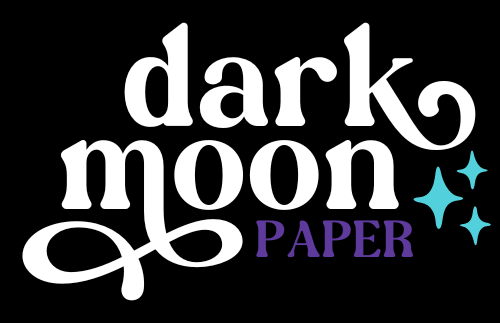
Why use planner stickers?
Planner stickers make organizing easy, fun, and personal! Add color, creativity, and structure to every page, transforming your planner into a tool that reflects you. Perfect for tracking, decorating, and staying inspired daily!
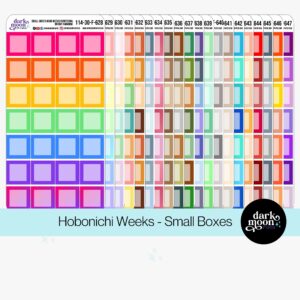


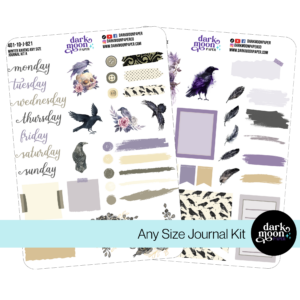


Hello and welcome!
I’m Rachael Snow, a lifelong artist and entrepreneur, and I started Dark Moon Paper to blend my love of art, technology, and the mysterious beauty of the world around us. My sticker kits are meant to set the mood, tell a story, and give you a little escape from the ordinary.
I work from my cozy studio tucked away in the beautiful woods of Oregon, surrounded by nature and a dark night sky full of stars.